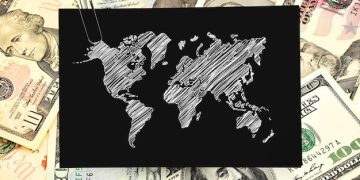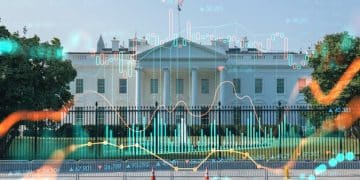Inflation Watch: How 3.2% Inflation Affects Your Wallet

Inflation Watch: How the Current 3.2% Inflation Rate Affects Your Purchasing Power examines the impact of the current inflation rate on consumers, focusing on how it reduces the real value of money and changes spending habits, along with strategies to mitigate these effects.
The latest Inflation Watch: How the Current 3.2% Inflation Rate Affects Your Purchasing Power report signals subtle shifts in the economic landscape, prompting individuals and families to reconsider their financial strategies. It’s not just about higher prices; it’s about how far your dollar can stretch.
Understanding the Basics of Inflation
Inflation is more than just a buzzword in financial news; it’s a real force that shapes the economy and impacts your daily life. Getting to grips with what it is and how it works is the first step in managing its effects.
At its core, inflation refers to the rate at which the general level of prices for goods and services is rising, and subsequently, purchasing power is falling.
What Causes Inflation?
Inflation doesn’t just happen; it’s driven by various economic factors. One common cause is demand-pull inflation, which occurs when there’s an increase in demand for goods and services that outstrips supply.
- Increased Demand: When consumers have more money to spend or are more willing to spend, demand rises.
- Limited Supply: If supply can’t keep up with this increased demand, prices go up.
Another factor is cost-push inflation, which happens when the costs of production increase, leading businesses to raise prices to maintain profitability.
- Rising Production Costs: This includes things like raw materials, wages, and energy.
- Business Response: Businesses pass these costs onto consumers in the form of higher prices.
Understanding these causes helps to contextualize the current inflation rate and anticipate future trends.

In conclusion, inflation is a complex phenomenon influenced by many different economic factors. By understanding these factors, you’ll better understand the impact of inflation on your personal finances.
The Current Inflation Rate: A Closer Look at 3.2%
The current inflation rate of 3.2% represents an important data point in understanding the economic climate of the United States. But what does this number really mean for you, and how does it affect your purchasing power?
First and foremost, a 3.2% inflation rate means that, on average, the prices of goods and services are 3.2% higher than they were a year ago.
How the Inflation Rate is Calculated
The inflation rate is primarily calculated using the Consumer Price Index (CPI), which measures the average change over time in the prices paid by urban consumers for a basket of consumer goods and services.
- Data Collection: Statisticians collect data on the prices of hundreds of items across various categories.
- Weighting: These items are weighted based on their relative importance in the average consumer’s spending.
The CPI then tracks these prices over time to calculate the percentage change, which represents the inflation rate.
Breaking Down the 3.2%
The 3.2% inflation rate isn’t uniform across all sectors. Some areas may experience higher inflation, while others may see lower rates.
- Essential Goods: Essential goods like food and energy tend to be more volatile.
- Services: Sectors like healthcare and education often experience inflation above the average rate.
This understanding allows you to better assess how inflation is affecting your specific spending habits and financial planning.
In summary, the 3.2% inflation rate is a critical metric that reflects the overall price increase in the economy, affecting consumers differently based on their spending patterns and needs.
How Inflation Erodes Your Purchasing Power
Inflation’s impact on your purchasing power is one of the most tangible ways it affects your financial well-being. As prices rise, each dollar you earn buys less than it did before.
This erosion of purchasing power can have a significant impact on your ability to maintain your current lifestyle and achieve your financial goals.
The Real Value of Money
The real value of money is its ability to purchase goods and services. When inflation rises, the real value of money decreases.
For instance, with a 3.2% inflation rate, $100 today will only buy approximately $96.80 worth of goods and services next year. This loss in value is what economists refer to as the erosion of purchasing power.
Impact on Savings
Inflation can also diminish the value of your savings. If the interest rate on your savings account is lower than the inflation rate, you’re losing money in real terms.
- Low Interest Rates: Many savings accounts offer interest rates that are below the current inflation rate.
- Decreased Value: As a result, your savings buy less over time.
To counteract this, it’s important to explore investment options that offer returns higher than the inflation rate.
In conclusion, inflation directly impacts your purchasing power by reducing the real value of money and affecting the growth of your savings. Recognizing this impact allows you to make more informed financial decisions.
Consumer Spending Habits in Times of Inflation
When inflation rises, consumers often adjust their spending habits to cope with the higher prices. These changes can ripple through the entire economy, affecting businesses and overall economic activity.
Understanding these consumer responses is crucial for both businesses and individuals to navigate inflationary periods.
Cutting Back on Non-Essentials
One of the first responses to inflation is cutting back on non-essential spending. This includes things like dining out, entertainment, and luxury goods.
- Reduced Discretionary Spending: Consumers prioritize essential goods and services.
- Impact on Businesses: Businesses in non-essential sectors may see a decrease in sales.
This shift can force businesses to adjust their strategies, such as offering more affordable options or focusing on maintaining customer loyalty.
Seeking Lower Prices
Consumers also tend to become more price-sensitive during inflation, actively seeking out lower prices and better deals.
- Comparison Shopping: Consumers spend more time comparing prices at different stores.
- Switching Brands: They may switch to cheaper brands or generic products to save money.
This behavioral change puts pressure on businesses to remain competitive and offer value for money.
Delaying Purchases
Another common strategy is delaying major purchases until inflation eases or until absolutely necessary. This can include items like cars, appliances, or home renovations.
In conclusion, consumer spending habits change significantly during times of inflation. These changes ultimately shape market dynamics.
Strategies to Protect Your Purchasing Power
While inflation can erode your purchasing power, there are several strategies you can implement to protect your financial well-being during inflationary periods. These strategies range from investing wisely to adjusting your budget.
Taking proactive steps can help you maintain and even grow your wealth despite rising prices.
Investing in Inflation-Resistant Assets
Investing in assets that tend to hold their value or even increase in value during inflation is a key strategy.
Real estate, for example, can be a good hedge against inflation. As prices rise, so too does the value of property.
- Rising Rents: Landlords can increase rents, providing a hedge against inflation.
- Property Value Appreciation: Property values tend to increase over time.
Another option is investing in Treasury Inflation-Protected Securities (TIPS), which are designed to protect investors from inflation.
- TIPS returns will increase and decrease with inflation
- Principal and interest are protected.
Adjusting Your Budget
Revisiting and adjusting your budget is essential to ensure you’re making the most of your money.
- Track Expenses: Identify areas where you can cut back on spending.
- Prioritize Needs: Focus on essential expenses and reduce discretionary spending.
By carefully managing your budget, you can mitigate the impact of inflation on your finances.
Negotiating and Seeking Discounts
Take the time to negotiate prices and seek out discounts wherever possible. This can include negotiating bills, comparing insurance rates, and using coupons.
In summary, protecting your purchasing power requires a combination of strategic investing, careful budgeting, and proactive negotiating. By implementing these strategies, you can weather inflationary periods more effectively.
The Impact of Inflation on Different Income Groups
Inflation affects different income groups in varying ways, with lower-income households often feeling the pinch more acutely. Understanding these disparities is crucial for crafting effective economic policies.
The impact of inflation is not uniform across the socio-economic landscape. Some groups struggle more than others, depending on their lifestyle.
Lower-Income Households
Lower-income households spend a larger portion of their income on essential goods and services. When prices rise, lower-income individuals can suffer to a greater degree.
- Disproportionate Impact: Lower-income households have far less savings.
- Limited Flexibility: Lower-income households cannot be picky about the services they need, for example healthcare.
Middle-Income Households
Middle-income households strike a balance between essential and discretionary spending. The impact on these households depends largely on how they manage their finances.
- Reduced Discretionary Spending: They may need to cut back on non-essential purchases.
- Savings Concerns: Middle-income households may need to tap into their savings or change their investment strategies.
Higher-Income Households
Higher-income households typically have more financial flexibility to absorb the impact of inflation. They may have more savings and investments to fall back on.
In conclusion, the impact of inflation varies significantly across different income groups. Lower income individuals feel the pinch more, whereas upper income generally have more financial stability. Recognizing these disparities is essential for crafting equitable economic policies that support everyone.
| Key Point | Brief Description |
|---|---|
| 💸 Inflation Impact | Reduces purchasing power, affecting how much you can buy with the same amount of money. |
| 📊 Current Rate | The current inflation rate is 3.2%, meaning prices are 3.2% higher than last year. |
| 🛡️ Protection | Strategies such as investing wisely and adjusting your budget can protect your wealth. |
| 💰 Spending | Consumers often cut non-essential spending and seek lower prices to cope with inflation. |
Frequently Asked Questions
▼
Inflation is the rate at which the general level of prices for goods and services is rising, and subsequently, purchasing power is falling.
▼
Investing in inflation-resistant assets, adjusting your budget, and seeking discounts are effective strategies to protect your purchasing power.
▼
The CPI is a measure that examines the average change over time in the prices paid by urban consumers for a basket of consumer goods and services.
▼
Inflation affects different income groups in varying ways, with lower-income households often feeling the pinch more acutely due to a larger portion of income being spent on essential items.
▼
Inflation-resistant assets are those that tend to hold their value or increase in value during inflation, such as real estate and Treasury Inflation-Protected Securities (TIPS).
Conclusion
In conclusion, understanding Inflation Watch: How the Current 3.2% Inflation Rate Affects Your Purchasing Power is crucial for making informed financial decisions, from adjusting your budget to making strategic investments. By proactively managing your finances and staying informed about economic conditions, you can protect your purchasing power and achieve your financial goals.





